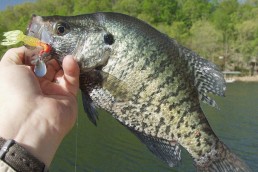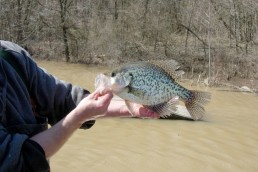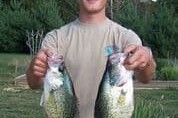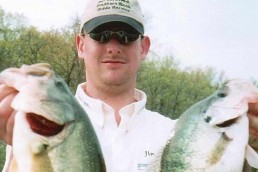Crappie Time in the Ozarks
SHARE THIS POST
It is crappie time for most of the Ozarks. In the shallow parts of highland reservoirs the spawn is underway, but in the deeper, lower parts, it could be another week or two before the spawn peaks. The demand for minnows and small jigs has already hit the bait shops and their supply chain.
These little cousins of the largemouth bass are one of North America’s most sought-after fish species. Anglers pursue them in all seasons for their delicate fillets, usually dipping them in batter and frying them in hot oil.
For the ichthyologist (one who studies of fish) in you, most highland reservoirs include Pomoxis annularis, or white crappie, especially at Lake of the Ozarks in Missouri. However, there are some Pomoxis nigromaculatus, or black crappie.
According to Greg Stoner, MDC Fisheries Management Biologist for the lake, there is a growing population of black crappies there due to the lake becoming clearer.
Crappies answer to several names, like calico or strawberry bass, spotted and silver crappies, bachelor, speckled bass or speckled perch (specks), newlight, papermouth, Oswego bass and sac-a-lait (sack of milk), depending where they’re fished.
White crappies are often mistaken for blacks during the spawn because breeding white males take on a dark coloration. However, on closer examination black crappies have deeper bodies than their white counterparts and the black’s spots are random patterns, while the white’s form vertical bands. Most black crappies have seven or eight dorsal spines while whites have five or six.
Fortunately, crappies are a very prolific fish. Females lay from 5,000 to 30,000 eggs. After hatching, they feed on zooplankton and insect larvae, later switching to a diet of small fish like minnows and shad.
Keeper lengths can vary too. At my home lake, the legal keeper-length is 9-inches, however many anglers release fish under 10-inches long, opting for the larger fish with meal-sized fillets.
“Based on angler feedback and our crappie mortality studies, we are considering a 10-inch minimum length limit for Lake of the Ozarks,” Stoner says.
Since length limits may vary in Missouri and other mid-south impoundments, anglers should be aware of local regulations.
It is spawning season in the Mid-South, and crappies are most vulnerable when they are creating and protecting nests.
Are you enjoying this post?
You can be among the first to get the latest info on where to go, what to use and how to use it!
In his book, Fishes of Missouri, William L. Pflieger states, “Nesting activity begins when the water temperature rises to about 56 degrees F.”
He adds that crappies spawn on silt-free substrate areas like fine gravel in protected coves, away from wave action. Nesting sites include submerged logs, roots, or tree limbs.
According to lake-area bait shops, medium-minnows are the best size live bait and jig anglers are having great success with blue ice-and-white or black-and-chartreuse colors. Favorite alternatives include red-and-chartreuse, smoke or clear with silver sparkle or white.
Anglers should have a good selection of jigs and plastic tails in various sizes. Start with a 1/8-ounce jig head and 3-inch curly tail, and work down in size to 1/16- or 1/32-ounce heads. The fish will soon let you know which they prefer.
The water is quite clear in most coves now, and one of the biggest mistakes anglers make is fishing too shallow on sunny days. Like most fish, crappies prefer to spawn where light penetration ends. During the day this means at 4 to 6 feet, or 3 to 5 feet at dawn and dusk.
Terminal tackle varies depending on preference. Some like spin-cast rigs, while others prefer spinning tackle.
And no matter which rig you prefer, fresh line is critical. Small jigs work best on thin-diameter line, like 6- to 10-pound-test. Check the line frequently, since it can “nicked up” easily and break around brush and docks.
Live-bait anglers that learn to use a slip bobber can have an advantage over jig anglers around brush because setting the minnow’s depth to just clear the brush tops is easy and repeatable. This avoids excessive snags while keeping the bait in the fish zone.
Now, you have some crappies in the livewell or fish basket. Next, clean and eat them, of course, because tasty crappies are also an excellent source of protein and heart healthy omega oils. Most anglers fillet their crappies, and then remove the skin and fatty tissue around the belly and dorsal fins to help remove any fishy taste.
If you are on a low-fat diet, try dipping the fillets in egg white then flour or cornmeal. Season with a little lemon-pepper and fry them quickly in a skillet using only 2 or 3 tablespoons of canola oil—don’t overcook them. A hot roll, sliced fresh tomatoes, steamed green beans and seasoned new potatoes can finish off the meal. Use a low or non-fat butter spray on the beans and potatoes for flavor without the dreaded cholesterol and calories.
MWO
SHARE THIS POST
Did you enjoy this post?
You can be among the first to get the latest info on where to go, what to use and how to use it!
Darrell Taylor
Darrell Taylor has fished for more than 65 years. During the past 25 years, Taylor has generated more than 2,000 published articles, columns and fishing reports. His writings received 14 peer-level awards from outdoor writer organizations, including the Association of Great Lakes Outdoor Writers “Excellence in Craft” Golden Glow Award, their highest recognition.



